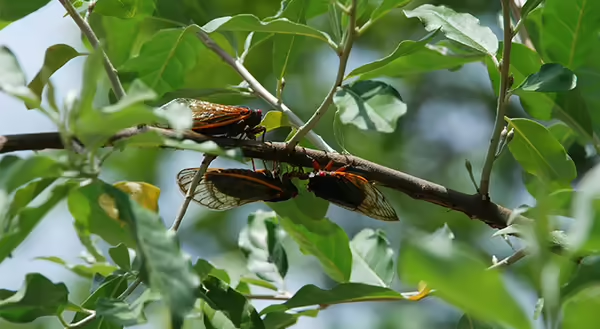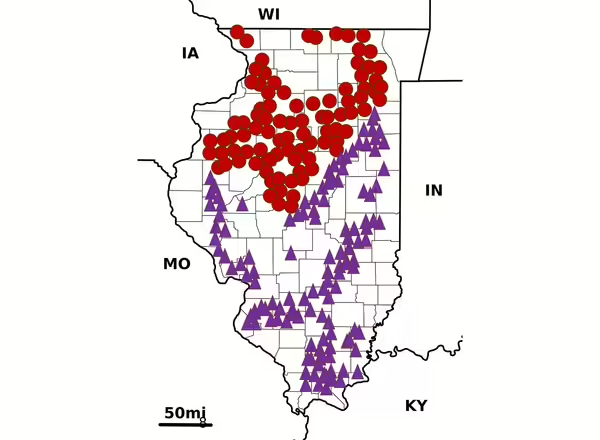
As you have probably heard, very soon our state will be host to two broods of periodical cicadas. Here in Illinois, we actually have five broods of periodical cicadas and so every couple of years some part of the state will be host to periodical cicadas. 2024 is special because it is uncommon for two broods to be out in one year. The geographic spread of periodical cicadas will be much wider in Illinois than in a normal cicada year (Figure 1, Red dots, Northern Illinois Brood; Purple triangles, Great Southern Brood).
Periodical cicadas do not sting or bite. Feeding on trees is also not how they do damage. Periodical cicadas damage trees when they lay their eggs in small branches and twigs, ½ to 1 inch in diameter. They really only do harm to very young trees, so if you have young fruit or ornamental trees, the best control option is protective netting with mesh less than ¼ inch. If you have a large number of fruit trees and cannot add mesh to them, there are insecticide options for you.
Cicadas will start emerging when the soil temperatures are 64°F at 7 to 8 inches in depth. If temperatures remain high, we could see emergence earlier than expected. We may start seeing some cicadas in mid May. The males will emerge first and start singing so you will be alerted to their presence. The females will be laying eggs 7-10 days after male singing. You can time your insecticide sprays with the adult emergence. The general recommendation is first through third cover.
This is a spray guide for periodical cicadas for commercial tree fruit producers only!!! If you have a few fruit trees in your yard, please do not spray for periodical cicadas. Also, if you have lived on your property for 13 or 17 years and you have not dealt with cicadas before, you are unlikely to experience them this year. Almost all of the labeled insecticides are pyrethroids (IRAC Code 3A). Also, always read and follow insecticide labels!
|
Product |
Active Ingredient |
IRAC Code |
Efficacy |
REI (hrs) |
PHI (days) |
|
Asana XL |
esfenvalerate |
3A |
Excellent |
12 |
21 |
|
Danitol 2.4EC |
fenpropathrin |
3A |
Excellent |
24 |
14 |
|
Sevin XLR Plus |
carbaryl |
1A |
Good |
12 |
3 |
|
Baythroid XL |
cyfluthrin |
3A |
Unknown |
12 |
7 |
|
Delta Gold |
deltamethrin |
3A |
Unknown |
12 |
21 |
|
Proaxis |
gamma-cyhalothrin |
3A |
Unknown |
24 |
21 |
|
Warrior II |
lambda-cyhalothrin |
3A |
Unknown |
24 |
21 |
|
Neemix 4.5 |
azadirachtin |
un |
Unknown |
12 |
0 |
Photo Credit for the image of cicadas at the beginning of the article: Pennsylvania Department of Conservation and Natural Resources-Forestry, bugwood.org
